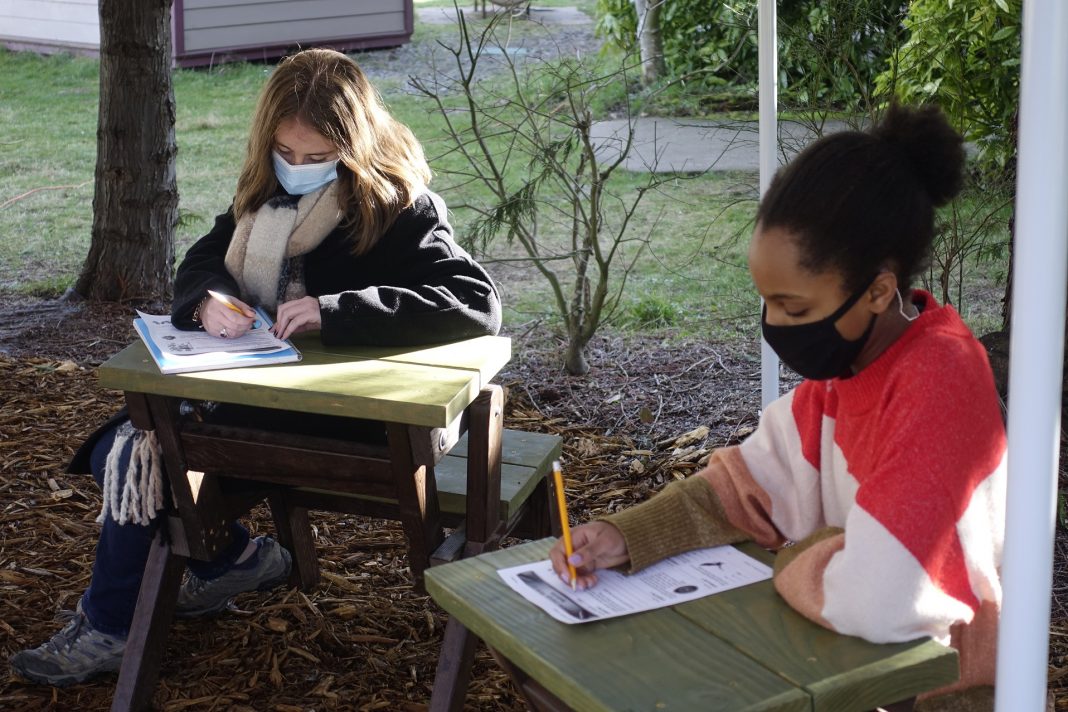When all the local schools resorted to distance learning last fall, Olympia Waldorf School followed suit and immediately began planning for their students’ return. “We made the best of it,” says Stephanie Redden, the school’s business director and administrator. “We taught all of March, April, May and into June through the online portals. But we realized that if we could, the best thing we could do is get the students back on campus.”
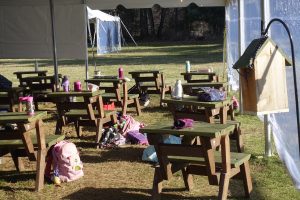
In a school where nature is a vital part of the daily curriculum, their solution may look different than you expect. Originally known as Chambers Prairie School in 1916, the yard in front of the historic schoolhouse is now dotted with tall, white marquees holding desks and chalkboards, and in front, birdhouses housing hand sanitizer instead of nests. Children, grades first through eight, rotate through the day from their ventilated indoor classrooms with slippers and sweaters to their outdoor classrooms with coats and gloves.
“On a sunny day it is beautiful,” says Stephanie, “but it does get harder when it’s rainy. And it’s not like they’re playing the whole time. You do have to sit down and do the work.”
Eighth grader, Malaika Mabwa-Childress, agrees. “It can get cold,” she says with a nod, “I did like having online school days because I got to sleep in a bit but it’s really nice to be able to get exercise during the day. Even though it is cold, I get to spend time with my class.”
The camaraderie of the classes is palpable. “I can only explain our class as kind of like a big family,” fellow eighth grader Andrea Redden adds thoughtfully. “We are really close.”
Lasting Relationships, Lasting Knowledge
In a Waldorf school, teachers move through the grades with their students. “You get to form a relationship with your teacher,” explains Malaika, “instead of getting to know them for one year, and then just moving on.”
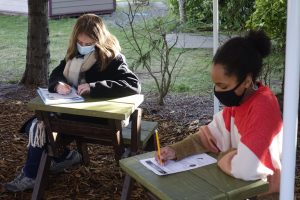
Sweekriti Apple, a Waldorf teacher of over 20 years, has taught many students from first through eighth grade graduation. She was a Waldorf student at her parent’s school in the Himalayas. Then, after accepting an academic scholarship to Emerson College in England, Sweekriti went on to become a Waldorf teacher herself.
“A lot of people think, ‘Oh, going to Waldorf school is going to art school.’ That’s a misconception,” explains Sweekriti. “The way we approach academics is more of an experiential learning, which then becomes memory rather than information-based. What we are doing is having students experience it, so that they can remember it and then they constantly keep the knowledge for the long-haul.”
Together and Safe
When third grader Evelyn Wheeler-Rauscher transferred to Waldorf this past year, her parents had worries for both the transition and the COVID-19 virus, “We had concerns on how Evelyn would do with meeting new classmates and school staff, learning new rules and cultural norms, and working within a different educational philosophy,” says Evelyn’s parents Brian Rauscher and Justin Wheeler. “And, of course, worrying about how COVID protocol would both keep her safe and not be too overwhelming or scary for her.”
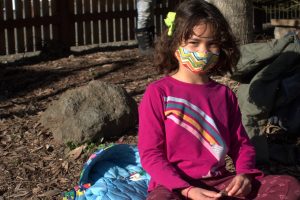
“We have been super lucky and haven’t had a single case on campus,” says Stephanie of COVID-19, “and part of that is families being careful and taking care of themselves at home. Our reopening was a long and thought-out process.”
Though about 30% of the students chose to homeschool in the fall, some returned in person as the year progressed. “Families realized the school was working in a very safe manner and that we were making it happen,” explains Stephanie. “And there are families like Evelyn’s who had done the online schooling in the spring with public schools and who were looking for other options. They ended up here.”
Multi-Tiered Support
Speaking with Evelyn, you understand right away that this is a child with a lot of spirit. “In my old school we didn’t get to go outside very much,” she confides, “there wasn’t art, there wasn’t a lot of things.” If you ask what she likes to do in class now the list tumbles effortlessly, “I like when we are cooking or go outside for gardening and Spanish and reading.” Pausing, Evelyn emphasizes, “I do like reading.”
Reading also came up as one of eighth grader Andrea’s favorite activities. That was not the case when she arrived at Waldorf in the third grade. “I think the biggest thing my teacher has done for me, personally, is helping me with my disability,” says Andrea. “I’m dyslexic, so reading and writing don’t come easily to me. She has been really supportive of me. So that helps.” Smiling, Andrea adds, “and I love reading.”
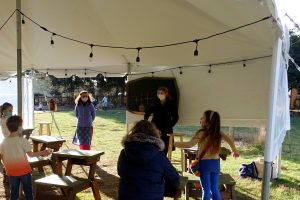
That support to the student is key to Waldorf education, says Sweekriti. And on a social level, communication is key. “A lot of teachers have class meetings to work through things that might be troubling and that need to be shared and talked about. When issues arise, it’s the teacher sitting and actually listening to both sides, really working through it without necessarily having punitive consequences. There is a lot of support here.”
One of the many changes Evelyn’s dad has seen in his daughter is her relationship with classmates. “Socially, Evelyn talks positively about all of her classmates,” says Justin, “as opposed to her previous schooling where she focused on 2-3 friends exclusively. And, she is quick to tell us about experiences, lessons and activities from her day.”
Guidance and Experience
The lessons look differently than you might expect too. While watching the third-grade Spanish language class, Evelyn and her classmates sit in their outdoor door classroom eyes closed and heads on their desks. Luis Allende, their teacher, lightly taps each student on the back several times. Popping up, the student calls out in Spanish the number of taps they felt.
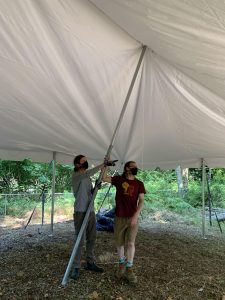
“It’s about the quality rather than quantity of things,” says Sweekriti, “so that it is more of an experience, first, then put into practice.” Sweekriti explains a middle school chemistry lab involving cabbage juice for testing acids and bases. “But rather than just saying, ‘Oh, read the chapters, answer these questions, and do this lab,’ it’s more, ‘Let’s do this together, let’s have a collective idea of what it is.’ And then engaging them in discussion because, of course, we know all of these things, but when they share it with you, then it’s coming from them.”
Imagination. Truth. Responsibility
A Waldorf education focuses on the whole child, integrating art, movement, music that all revolve around the rhythms of the natural world. Starting with the pre-K toddlers where most of their time is spent exploring nature, the students broaden that path while exploring academic concepts.
“Our highest endeavor must be to develop free human beings who are able of themselves to impart purpose and direction to their lives. The need for imagination, a sense of truth, and a feeling of responsibility—these three forces are the very nerve of education.” Rudolph Steiner founder of Waldorf Education
For eighth graders Malaika and Andrea, next year will be a new experience of changing schools and moving into high school. When asked if she saw any challenges with this transition, Sweetkriti was quick to respond, “They have excelled,” she says emphatically, “I look at them and I see once very soft-spoken children very much standing toward the back. But now, they have gotten a voice and are just shining. And I think that is a big part of our school, and Waldorf education in general, it allows us to shine.”
Call the Waldorf School to schedule a tour at 360.493.0906.
Sponsored






































